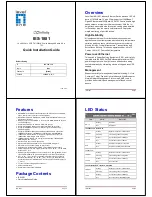
Run PVST+ on both VLT peer switches. PVST+ instance will be created for every VLAN configured in the
system. PVST+ instances running in the Primary Peer will control the VLT-LAGs on both Primary and
Secondary peers. Only the Primary VLT switch determines the PVST+ roles and states on VLT ports and
ensures that the VLT interconnect link is never blocked. PVST+ instance in Primary peer will send the
role/state of VLT-LAGs for all VLANs to the Secondary peer. Secondary peer will use this information to
program the hardware. PVST+ instance running in Secondary peer will not control the VLT-LAGs.
Dell Networking recommends configuring the primary VLT peer as the primary root device for all the
configured PVST+ Instances and configuring the secondary VLT peer as the secondary root device for all
the configured PVST+ Instances.
Sample PVST+ Configuration
The following examples show the PVST+ configuration that you must perform on each peer switch to
prevent forwarding loops.
Configure PVST+ on VLT Peers to Prevent Forwarding Loops (VLT Peer 1)
Dell_VLTpeer1(conf)#protocol spanning-tree pvst
Dell_VLTpeer1(conf-pvst)#no disable
Dell_VLTpeer1(conf-pvst)#vlan 1000 bridge-priority 0
Configure PVST+ on VLT Peers to Prevent Forwarding Loops (VLT Peer 2)
Dell_VLTpeer2(conf)#protocol spanning-tree pvst
Dell_VLTpeer2(conf-pvst)#no disable
Dell_VLTpeer2(conf-pvst)#vlan 1000 bridge-priority 4096
Configure both ends of the VLT interconnect trunk with identical PVST+ configurations. When you
enable VLT, the
show spanning-tree pvst brief
command output displays VLT information.
Dell#show spanning-tree pvst vlan 1000 brief
VLAN 1000
Executing IEEE compatible Spanning Tree Protocol
Root ID Priority 0, Address 90b1.1cf4.9b79
Root Bridge hello time 2, max age 20, forward delay 15
Bridge ID Priority 0, Address 90b1.1cf4.9b79
We are the root of Vlan 1000
Configured hello time 2, max age 20, forward delay 15
Interface
Designated
Name PortID Prio Cost Sts Cost Bridge ID
PortID
---------- -------- ---- ------ ----------- ------- --------------------
--------
Po 1 128.2 128 188
FWD(vltI)
0 0 90b1.1cf4.9b79
128.2
Po 2 128.3 128 2000
FWD(vlt)
0 0 90b1.1cf4.9b79
128.3
Te 1/10 128.230 128 2000 FWD 0 0 90b1.1cf4.9b79
128.230
Te 1/13 128.233 128 2000 FWD 0 0 90b1.1cf4.9b79
128.233
Interface
Name Role PortID Prio Cost Sts Cost Link-type Edge
---------- ------ -------- ---- ------- ----------- ------- --------- ----
Po 1 Desg 128.2 128 188 FWD 0
(vltI)P2P
No
Po 2 Desg 128.3 128 2000 FWD 0
(vlt) P2P
No
Te 1/10 Desg 128.230 128 2000 FWD 0 P2P Yes
Virtual Link Trunking (VLT)
1063
Summary of Contents for S4820T
Page 1: ...Dell Configuration Guide for the S4820T System 9 8 0 0 ...
Page 282: ...Dell 282 Control Plane Policing CoPP ...
Page 622: ...Figure 81 Configuring Interfaces for MSDP 622 Multicast Source Discovery Protocol MSDP ...
Page 623: ...Figure 82 Configuring OSPF and BGP for MSDP Multicast Source Discovery Protocol MSDP 623 ...
Page 629: ...Figure 86 MSDP Default Peer Scenario 2 Multicast Source Discovery Protocol MSDP 629 ...
Page 630: ...Figure 87 MSDP Default Peer Scenario 3 630 Multicast Source Discovery Protocol MSDP ...
Page 751: ...10 11 5 2 00 00 05 00 02 04 Member Ports Te 1 2 1 PIM Source Specific Mode PIM SSM 751 ...
Page 905: ...Figure 112 Single and Double Tag First byte TPID Match Service Provider Bridging 905 ...
Page 979: ...6 Member not present 7 Member not present Stacking 979 ...
Page 981: ...storm control Storm Control 981 ...
Page 1103: ...Figure 134 Setup OSPF and Static Routes Virtual Routing and Forwarding VRF 1103 ...
















































